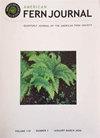巴西半干旱区隐种Isoëtes的分类及多倍体母系起源的推测
IF 0.9
4区 生物学
Q4 PLANT SCIENCES
引用次数: 1
摘要
摘要揭示隐蔽物种中未被识别的多样性对整个植物群的分类学、系统学、进化研究和物种保护具有深远的意义。Isoëtes由于其形态的简单性、停滞性和收敛性,容易出现高比率的隐蔽物种形成。系统发育研究揭示了该属来自巴西半干旱地区(Caatinga)的隐蔽物种,该地区是巴西研究最少、最濒危的植物群。在这里,我们进行了形态学分析和染色体计数,并利用已经发表的该属的系统发育分析,对Caatinga的Isoëtes进行了分类修订。anamariae和I.harleyi是两个新物种,它们是通过分子数据和细微的形态学特征揭示出来的。本研究提供了Caatinga物种最重要的形态分类特征的描述、染色体计数、插图,以及识别它们的关键。该地区的所有物种都是二倍体,我们展示了二倍体在查明巴西多倍体起源方面的重要性。本文章由计算机程序翻译,如有差异,请以英文原文为准。
Taxonomy of Cryptic Isoëtes Species from the Brazilian Semi-Arid Region, with a Note about the Putative Maternal Origin of Polyploids
Abstract. Revealing the unrecognized diversity within cryptic species has profound implications in the taxonomy, systematics, evolutionary studies, and species protections throughout plant groups. Isoëtes is prone to a high rate of cryptic speciation because of its morphological simplicity, stasis, and convergence. Phylogenetic studies revealed cryptic species in the genus from the Brazilian semi-arid region (the Caatinga), which comprises the least studied and most endangered flora in Brazil. Here we conducted morphological analyses and chromosome counts, and took advantage of phylogenetic analyses already published for the genus to provide a taxonomic revision of Isoëtes from the Caatinga. Isoëtes anamariae and I. harleyi are two new species, which were revealed by molecular data and subtle morphological characters. This study provides descriptions, chromosome counts, illustrations of the most important morpho-taxonomic characters of species from the Caatinga, and a key to identify them. All species from this region are diploid and we show the importance of diploids in detangling the origin of polyploids in Brazil.
求助全文
通过发布文献求助,成功后即可免费获取论文全文。
去求助
来源期刊

American Fern Journal
生物-植物科学
CiteScore
1.20
自引率
0.00%
发文量
28
审稿时长
6 months
期刊介绍:
The American Fern Journal is a peer-reviewed journal focused on the biology of ferns and lycophytes.
 求助内容:
求助内容: 应助结果提醒方式:
应助结果提醒方式:


